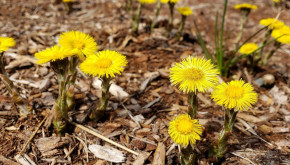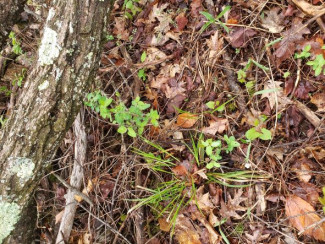
Written by Maddie Eberly, from Orono, Maine
Photo: Blooming coltsfoot (Tussilago farfara)
Snow and ice blanket the ground as winter goes through its turns. The only green not encased in snow and ice is on the conifers, whose bright green needles, grown in the previous season, have darkened to a deeper hue. The daily temperatures have begun to fluctuate, sometimes reaching above freezing multiple days in a row. Soon enough spring will be here.
The first flower here in Maine each spring is coltsfoot, Tussilago farfara. It is a gorgeous little flower with yellow petals that brightly pop against the muddy ground. Coltsfoot is an invasive plant, often found in roadside ditches and other human-disturbed areas. To be considered invasive, a plant must have arrived through human assistance to a location where it did not previously grow and can outcompete other plants there. Sometimes invasive plants are initially brought to new locations intentionally because we think they will help with erosion, can be used horticulturally or medicinally, or even make a potential agricultural tool or food. Sometimes, though, plants arrive accidentally via work equipment, modes of human transport, trade and parcel packaging, or other similar pathways. Coltsfoot, for instance, was historically used as a medicinal herb. Through mishap or with intention, these novel plants were naturalized and now grow exceptionally well in their new habitats and can displace other plants. Once established in a new location, these plants can travel further through the assistance of animals, water, and human activities.
As the snow disappears from last season’s harvest trails and landings, landowners should be keeping an eye out for invasive plants. Active forestry operations provide an excellent opportunity for invasive plants to enter a new ecosystem. Removing large trees and letting more sunlight in while disturbing soil with large equipment creates favorable conditions for the establishment of new populations. Invasive plants can be brought in by poorly cleaned equipment, from neighboring properties, or through various other pathways.
Spring is the best time to look for newly established plants. Their competitive nature often leads to them leafing out prior to many native plant species, making them easier to spot in the early growing months. Finding young plants early in the spring allows for well-timed management during the growing season; mature plants should be removed prior to producing seed. Correctly identifying a plant and understanding its phenology is key.
<< Their competitive nature often leads to them leafing out prior to many native plant species, making them easier to spot in the early growing months. >>
If left to grow, invasive plants can make it difficult for our forests to naturally regenerate following a harvest, something landowners in Maine depend on happening. Bittersweet vines, Celastrus orbiculatus, can grow quite fast in optimal conditions, strangling reserves of trees and casting shade on plants below. False glossy buckthorn, Frangula alnus, rapidly grows in shady understories or sun-soaked openings, causing it to reach unmanageable populations rapidly. Shrubby honeysuckles (Lonicera spp.), barberries (Berberis thunbergii and B. vulgaris), common buckthorn (Rhamnus cathartica), and many other species can cause ecological and economic damage to our forests if left unmanaged.
Early detection of newly established invasive plant populations decreases the number of resources needed to protect our native plants and ensure successful forest regeneration for continued sustainable forestry.
Identifying plants can be hard; if you are unsure of what to look for, reach out to your local foresters, land trusts, conservation organizations, or state programs with questions. Folks are eager to help!


